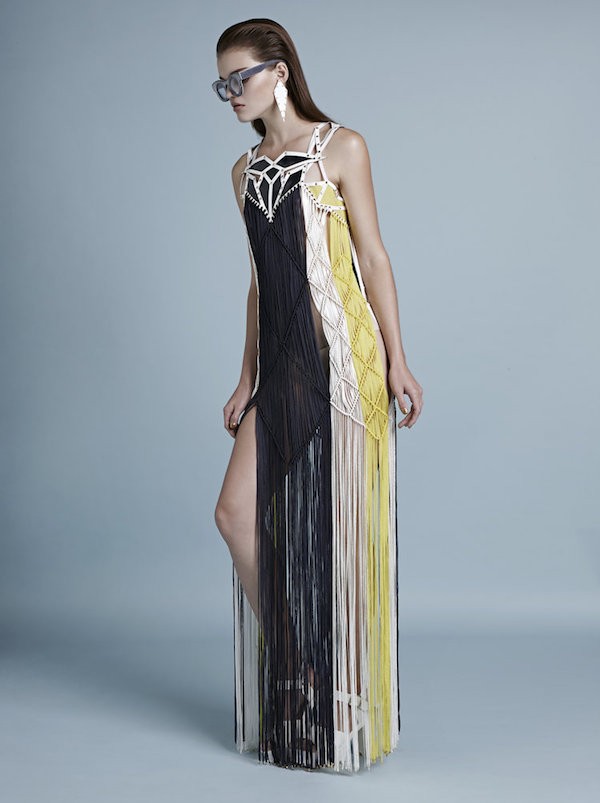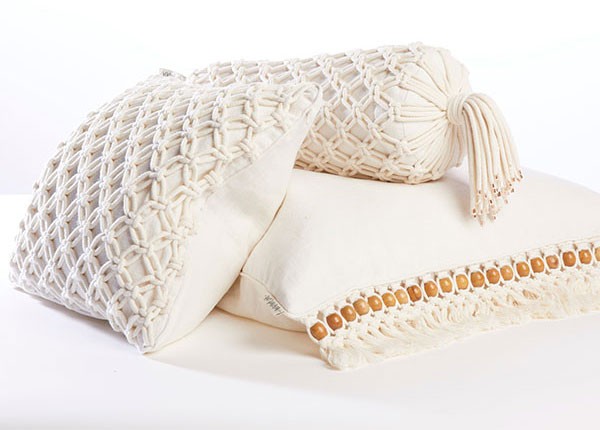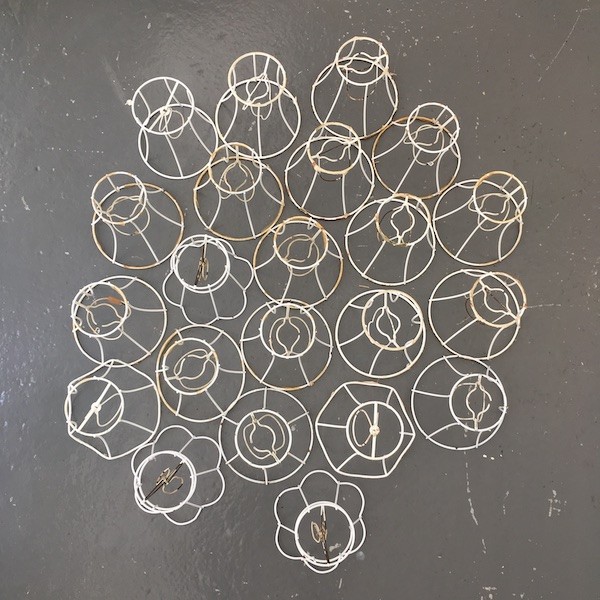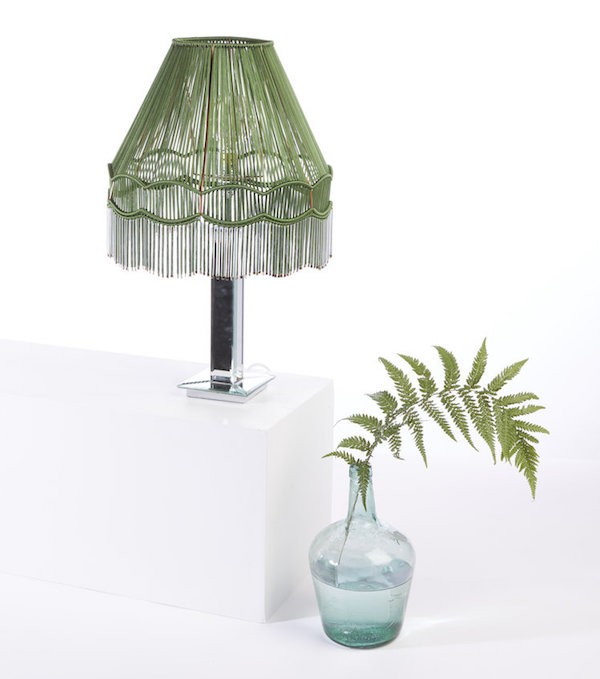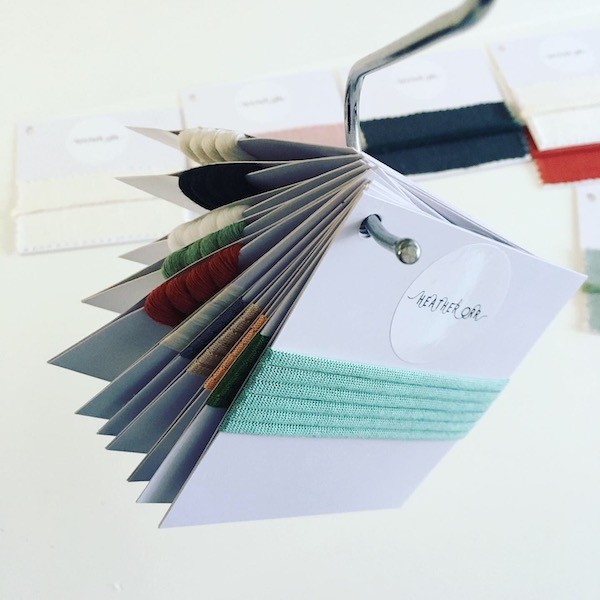After graduating in Constructed Textiles from the Royal College of Art, Folkestone-based textile designer Heather Orr forged a collaboration with fashion designer and fellow RCA graduate Jane Bowler.
Their bold collections gained a celebrity following – worn by the likes of Rita Ora and Little Mix; photographed by Nick Knight and Rankin for magazines such as Dazed and Confused, Vogue and Another Man.
SS15 dress designed by Jane Bowler x Heather Orr
With her innovate approach to textiles, Heather has now turned her skills to homeware, creating upcycled lighting with old vintage lampshades, reworked by hand with viscose, recycled cotton and paper raffia.
Other textile pieces in her collection include macrame cushions and plant hangers from sustainably produced textiles, all in a rich palette of colours.
Heather and Jane run workshops from East London and beyond, sharing a collective passion for unconventional materials and experimental processes.
We spoke to Heather about her craft, sustainability and the joy of making…
Q: Tell us about your design background
I’ve been working in the fashion and textile industry for the last ten years. I studied BA Textiles & Surface Design at Bucks New University and then went onto the RCA where I completed an MA in Constructed Textiles – Knit. Both courses were focused around machine-knitting and knitwear.
After leaving the RCA, I no longer had all of the fancy equipment and was limited for space, so I became increasingly interested in craft processes and self-taught myself a number of techniques.
It was whilst freelancing at the trend forecasting company WGSN that I began my collaboration with Jane Bowler, who was also working there. This was when I started experimenting with reclaimed and repurposed materials.
Q: How has your brand evolved into what it is today?
Having worked for various designers and studios over the last ten years, I always had an underlying desire to develop a brand of my own and explore the application of my textiles within an interior context.
One day, I was wondering around a junk shop in Ramsgate with a friend. I spotted a very tatty, nicotine-stained, but beautiful old lampshade. I couldn’t wait to get it home, remove the damaged fabric and see how it looked underneath. I loved the idea of rescuing these old frames and giving them a new lease of life.
I developed the rest of the collection around this first piece. Alongside the reclaimed products, I have incorporated a line of new lampshade frames, using recycled cords. The collection now consists of lighting pieces, handmade cushions and home accessories.
Q: What can you tell us about the making process?
As a textile designer, I find that the process and fabric should always inform the outcome and I tend to design in quite an organic way.
Each vintage lampshade I find is different and I love how it’s a surprise each time.
Having a dedicated space to work from has totally transformed how I work. I have the frames stripped and freshly coated in a rose gold colour in nearby Margate.
I made the move from London to the south-east coast two years ago and recently moved into a studio space in Folkestone’s Creative Quarter. I now have a specialist machine in the studio which cords the yarn I use, so I can offer a really bespoke service.
Q: What kind of interiors are your products most suited to?
I think our products work well in both residential and commercial interiors. Likewise, they suit both traditional and contemporary spaces as I feel they fuse a sense of old and new, modernity and nostalgia, a sense of the 1920s, 1970s and right now.
We would love to work on more commercial projects as there are so many bespoke options available, we really can adapt to any space, scale or colour-scheme. A few of our reclaimed lampshades have been spotted on the BBC’s Apprentice.
Q: Where do you find the reclaimed materials?
I’m constantly on the lookout for unusual frames and have my friends and family well-trained to scour charity shops and car boot sales. I also have to thank my very supportive fiancé for giving up his weekends to traipse round secondhand shops with me.
We use reclaimed wooden beads in our new Fringe Cushion which are actually salvaged from beaded carseat covers. For my workshops, I try to re-use any salvageable materials such as fabrics and trims from lampshades.
All of the cotton cord we use in our pieces is 100% recycled.
Q: Where do you draw inspiration for your designs?
I’m inspired by materials, processes and the second-hand objects I find. Flea markets make my heart race, and as much as I love contemporary design, there’s something about old things and nostalgia that makes me feel happy.
I also teach Fashion & Textiles and feel it’s important to immerse yourself in as many forms of art and culture as possible. It can be a little overwhelming at times, particularly with social media. I prefer to let the inspiration approach me or come from within. It’s intuitive.
Q: In your opinion, how do you make old objects and materials feel modern, elegant and luxurious?
I think it’s a case of keeping the aesthetic clean and simple. Colour has a role to play, but the colour palette I work with has a slightly nostalgic feel to it too. For me the materials and finish are key – they need to feel slick and refined.
Q: Can you tell us a bit about the workshops you run?
Yes! Running workshops has become a big part of what I do and it’s very rewarding. I get to meet a lot of interesting people, and each time I teach a technique, I feel I master it more myself.
My workshops range from making finished products to exploring processes and materials, whilst linking to mindfulness and wellbeing. We have run workshops in the past for the mental health charity Mind and for Kings College Hospital.
I run workshops at my studio and visit locations such as the V&A and Babington House. I also deliver Outreach workshops in schools, colleges and universities, including the RCA.
This year, I went to Portugal to run a workshop for Spotify Design and have previously visited the set of Call the Midwife to teach an actress a macramé technique for a scene.
Q: What do you believe is the link between making and wellbeing?
In a digital age, it’s good for us to be in touch with tangible objects and tactile processes. Sharing skills has a social impact and the group setting of a workshop is a sociable activity.
I find the process of creating something useful or sentimental with your own hands extremely gratifying. Not only that, when you become absorbed in a process it can be very therapeutic. Reaching a state of flow, when you are fully immersed in a process, is energising.
There is a great deal of research which demonstrates how participatory arts activities can help alleviate anxiety, depression and stress. In my experience, workshop participants simply seem to enjoy these activities and often comment on how therapeutic the processes are.
Q: Do you recognise a change in the role of sustainability in contemporary interior design?
I guess ’sustainability’ is a buzzword which everyone is trying to tap into at the moment. I think it’s great that people are taking more notice, but I think this has been the case for a long time in the design world.
For me, slow design, pieces that are made to last and to be treasured are the key. Then it’s important to look more closely at the materials and production processes being used.
There are some fascinating new sustainable materials out there. It’s great to see contemporary designers and the students I teach – the designers of the future, taking sustainability seriously.
I think consumers are beginning to show more appreciation for handmade objects and small-scale production. There seems to be a bit of a craft revival happening, which is great if you ask me!
❁
heatherorr.co.uk / @_heather_orr
This post contains affiliate links which means we may earn a commission should you decide to make a purchase. Thanks for supporting Upcyclist.co.uk


